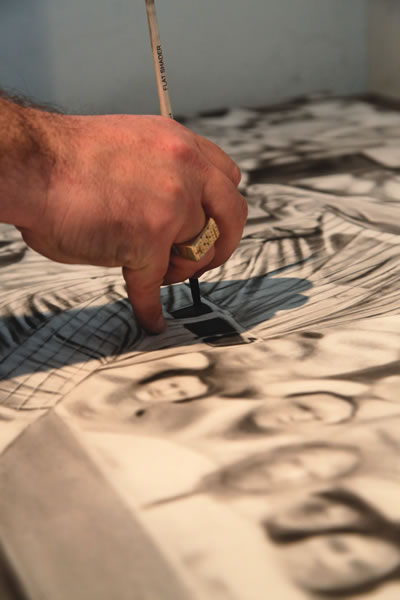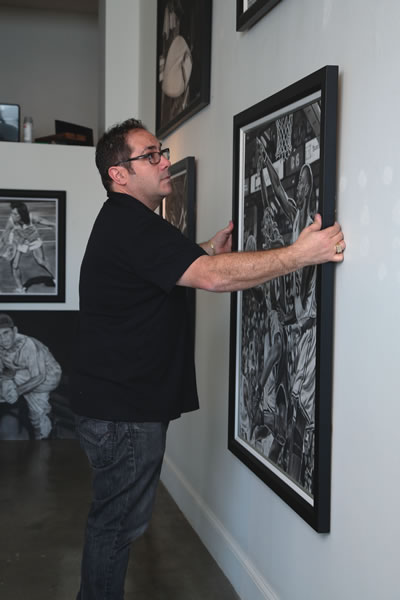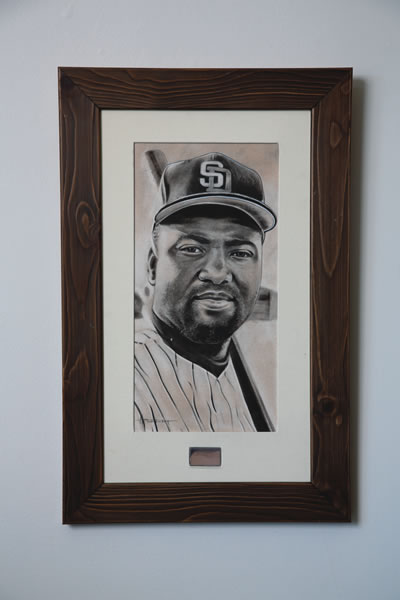swinging for the fences
Dave Hobrecht combines his lifelong passions to carve out a unique niche in the art world.
By Bruce Porter
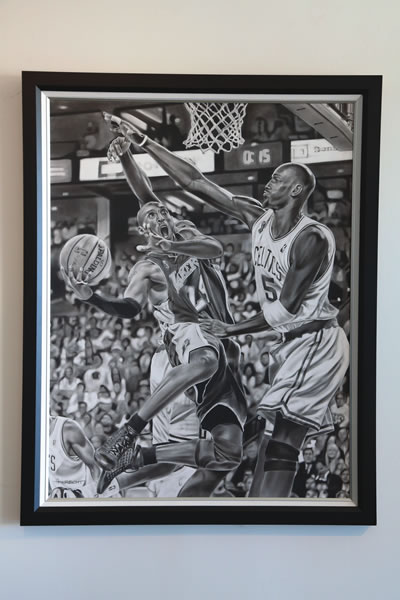 “I wasn’t thinking about art as a career,” Dave Hobrecht says from behind a small reception desk at his gallery in north Laguna. Well into his 30s before he was making enough money to drop his day job, it’s clear Dave intends to make the most of his artistic calling. First impressions defy the artistic stereotype—he’s too affable, too clean-cut, too grounded. But does any accomplished creative fit convention? “It was a hobby,” he continues, “something I loved doing.”
“I wasn’t thinking about art as a career,” Dave Hobrecht says from behind a small reception desk at his gallery in north Laguna. Well into his 30s before he was making enough money to drop his day job, it’s clear Dave intends to make the most of his artistic calling. First impressions defy the artistic stereotype—he’s too affable, too clean-cut, too grounded. But does any accomplished creative fit convention? “It was a hobby,” he continues, “something I loved doing.”
The paintings on display look like giant, stylized black-and-white photographs. Norman Rockwell is an obvious source of inspiration. There’s a lot of activity, even in the backgrounds—as if each scene holds more than one story. For the observer, the imagery conveys a palpable sense of adventure and high drama.
Dave’s work exhibits a deft eye for detail. But rather than jumping to categorize his style as a late entry to the photorealist movement that was popular during the Cold War era—artists like Cynthia Poole, who painted the Mars chocolate bar and other food packaging—there’s an equal pull to acknowledge the influence of modern graphic novels.
After all, most of his subjects could have been lifted from the pages of Sports Illustrated. Kirk Gibson’s walk-off home run in the World Series, Tony Hawk skating a quiet neighborhood pool with the relaxed confidence of a contest final, Smokin’ Joe Frazier fending off a vicious Muhammad Ali blow at the “Thrilla in Manila”—all are captured at precisely the right moment in time.
On Display
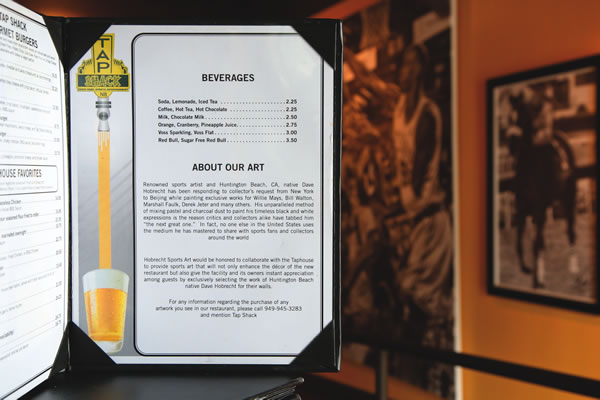
“We feature about 35 pieces at both our locations,” restaurateur Jeremy Foti proudly announces. His sports bars, the Tap Shack in Newport and the Tap House in Huntington Beach, have entire walls showcasing Hobrecht art. “We have an 8.5-foot Kobe Bryant that one person offered a substantial amount to buy right off the wall.” On his own initiative, Jeremy added a Dave Hobrecht biography page to his menus to answer patrons’ frequent curiosity about the unique sports art.
“I have some Stephen Holland paintings,” he adds, referencing another highly regarded sports artist, “but they don’t compare.” For his home, Jeremy commissioned several original works from Dave, including one of baseball pitcher Nolan Ryan with his entire family strategically blended into the stadium crowd. “I really like what Dave does. It has a look I’ve never seen before.”
“My method is a little different,” Dave says. “I can paint with oils and acrylics, but I’ve always loved charcoal.” He explains that, on its own, charcoal is too grainy. After sandpapering pastels into a fine dust, he mixes them with charcoal, and then uses a series of customized brushes to achieve the desired shade. For large paintings, Dave paints on canvas; for smaller ones, he uses durable hot-pressed watercolor paper glued to a flat wood backing.
He begins with a pencil sketch of shapes and outlines. “It looks like trash at the beginning,” he jokes. “[There are] tons of color base-coats and all these shapes. Then I do a whole layer of cutting things out with my erasers.” Although from a distance the paintings project a certain photographic quality, a closer examination reveals the extent to which creative license is taken with the lighting.
Original paintings can take up to 120 hours to complete. “The reason my originals take so long is that you have to build up layers,” he explains. “You can’t just take black paint to go over a black section.”
Artist by Accident
Dave’s technique and style are almost entirely self-taught. In grade school, like many boys growing up in the beach cities, all he wanted to do was play baseball and surf. On his first day of summer between grade and high school, however, Dave was hit by a car. His parents wondered if he would live through the night.
“It knocked a couple weeks out of me, so I don’t remember a lot about the accident,” he muses. “I was laid up for a long time.” With a body cast up to his waist and a dire prognosis of a permanent limp, Dave had a lot of time for board games and drawing. “My mom loaded me up with baseball cards and art supplies.”
Still, it would be years later before Dave would explore the possibility of making a living from his art. In college he was a business major. “I took one art class,” he recalls. “It was a horrible experience.”
He describes being at constant loggerheads with the instructor, who deemed his work too structured. Despite it being one of those courses in which merely turning in the assignments is usually enough to get an A, Dave managed to irritate the instructor into giving him a C. “It’s pretty funny,” he says. “I’d like to talk to him now, see what he thinks.”
After graduating from USC, he went to work for his father’s automotive accessories company, but as he says, “Selling auto parts just wasn’t for me.” In 2002, he called Surfer Magazine and said he wanted to be their new cartoonist. The editor agreed to run one of his cartoons, and if it received a positive response, he’d do another. “I did it for two years,” he remembers. “Didn’t make much money, but I loved it.”
Between cartoons for the magazine, Dave quietly began painting, developing the technique he now has down to a science. He submitted “Tree,” a 66-inch canvas of a pristine wave viewed from a tropical vantage point, to The Surfer’s Journal.
On the day the issue came out, a woman called from Hawaii and offered to buy the painting. “I loved that painting, and didn’t want to sell it,” Dave says. “I threw out a number that [was high enough that] I thought she’d say no.” She agreed without hesitation.
Around the time of his first major sale, commissioned works began pouring in. The USC football team asked Dave to do a painting. He captured UCLA basketball legend Bill Walton grabbing a fiercely contested rebound, who was so impressed that not only did he agree to sign the work, but he soon became Dave’s business partner. In 2011, Bill introduced Dave to Newport Beach investment bankers who went on to provide the capital to open his Laguna Beach gallery, Hobrecht Sports Art.
“What would take me to a new level was when I called Topps baseball cards,” Dave explains. It took some effort to get in contact with the decision makers, but he has since positioned himself as one of the select few artists who provide the famous trading card company with original art.
Topps mails 25 to 50 small, blank sketch cards at a time for Dave to paint portraits of athletes and entertainment personalities. They take his black-and-white drawings, colorize them digitally, and randomly insert them into retail packaging. On Ebay, Dave’s trading cards go for upwards of $500 each.
“He kind of gets it,” says Clay Luraschi, a Topps marketing executive. “He’s got one of those very distinctive styles. He understands what collectors like.”
Dave’s latest projects combine an element of the playing surface itself into his art. For a Derek Jeter painting, he ground earth from the new Yankee Stadium infield into the paint using a mortar and pestle. “This stuff is great to work with,” Dave says of the red dirt. “It’s got a clay-ish feel to it.”
For other paintings, Dave has incorporated turf from the Del Mar horse racing track, sand from Hawaii’s Pipeline beach, and bunker dirt from historic golf courses, all in the name of bringing some fun into his work. As compared to his trademark black and white, the result of this new technique is warmer, sepia tones.
Despite earning overwhelming popular acclaim, the contemporary art world has been slow to give Dave its seal of approval. “I sell my work to stadiums instead of museums,” Dave explains, clearly taking it all in his relaxed stride. “If you go outside that boundary, you’re more likely [to be called] a sellout. Go ahead and label me a sellout, just as long as I get to paint what I love.”
A rigorous schedule of 16-hour days, virtually seven days a week, doesn’t keep Dave, 41, from enjoying other, equally important aspects of his life. A single father of three—two daughters and a son—he drops his adolescent kids off at school every day and always gets home in time to prepare their dinner and help out with homework.
“That’s why I drink all that coffee,” he exclaims. “I’m backlogged a ton, so I can’t lighten up. But I make myself go to bed at midnight, so I can wake up the next day and do it again. I’m a fanatic, but I don’t get burned out.”
Now fully recovered from his life-changing car accident, Dave also finds the time to enjoy his new home in Laguna. “I grew up surfing, and there are some good spots around here. I love getting into the water.”
He mentions hiking in the canyons and exploring the tidepools, but it’s the community toward which he is particularly affectionate. “I love the art feel around here,” he says. “The people are so creative, so nice. Laguna has a great vibe—I don’t see myself ever leaving.” LBM



